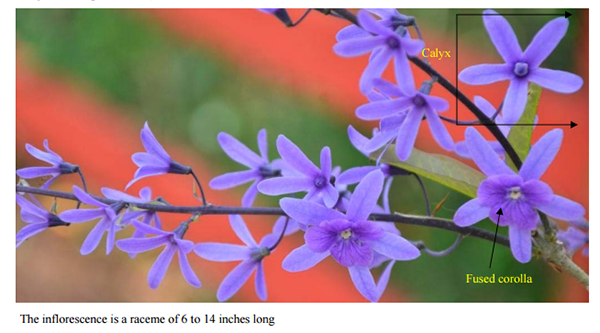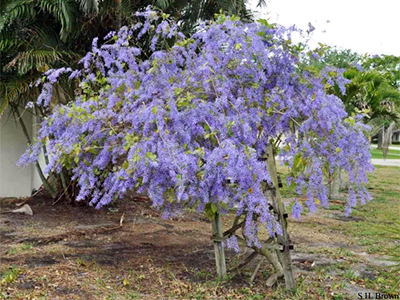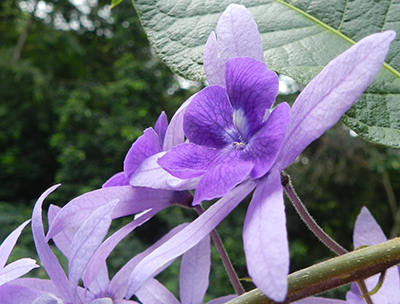Queen's Wreath
Queen's wreath (Petrea volubilis) is a stunning tropical vine that resembles wisteria with its drooping lavender flowers. You may know this vine by one of its other common names: Petrea, purple wreath, or sandpaper vine. The name sandpaper vine refers to the texture of the plant's leaves which are stiff and feel, as the name suggests, like sandpaper.
This tropical plant has a large native range. It can be found growing south from Southern Mexico through Central America on into northern and western South America down to Paraguay. Queen's wreath is also found growing in Cuba, Jamaica, Puerto Rico, and Hispaniola. Florida gardeners in zones 9B and south live in the perfect climate for growing this vine.
Characteristics
Queen's wreath flowers multiple times a year—most profusely between February and June. The flowers are densely packed in a form (called raceme) that, from a distance, resembles a bunch of grapes. The actual flowers are small and light blue or purplish. They will eventually fall, leaving the calyces. A calyx is the base of a flower and is usually green, but queen's wreath boasts purple calyces as attractive as the true flower petals. The calyces will persist for several weeks, providing your landscape with a little extended color. While the purple-flowered queen's wreath is more common, there is also a white-flowered cultivar, 'Albiflora'.

Photo of a queen's wreath flower, courtesy of Stephen H. Brown, UF/IFAS Extension Lee County.
This vine is described as being "variably deciduous," meaning leaf drop depends on the climate and weather in your specific area. Some plants may drop all leaves during the winter while others only drop some.
While usually found growing as a woody vine, queen's wreath can be maintained as a shrub or a small, single- or multiple-trunked tree. Left to its own devices, queen's wreath can reach 40 feet tall, but you can keep it much smaller with occasional pruning.
Planting and Care
Queen's wreath will grow best in full sun but can tolerate partial shade. This plant has high drought and wind tolerance and medium salt tolerance, making it great for coastal gardeners. Queen's wreath needs frequent watering to get established and young, small plants should be protected from frost. Once established your plant will need very little care, just occasional pruning and infrequent irrigation. Be sure to keep competing lawn grass away from the root zone. Another nice attribute of this plant is that it has no major pest problems.
Queen's wreath looks lovely when allowed to grow over a gated entrance, along fences, in a large container, or even clambering up a selected tree. Just be sure to provide your plant with a sturdy support structure when growing it as a vine.
It generally takes only two or three years for newly planted queen's wreath to begin flowering. Be aware that the first intense bloom of the season may leave your vine almost leafless, but never fear—leaves will return.
These plants may produce seeds, but they can also be propagated and passed on by cuttings or air layering.

A queen's wreath in full bloom. Photo courtesy of Stephen H. Brown, UF/IFAS Extension Lee County.


